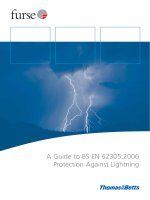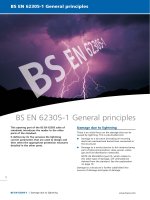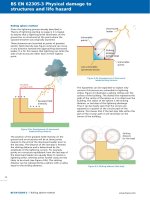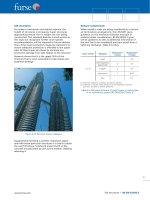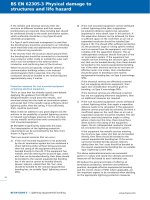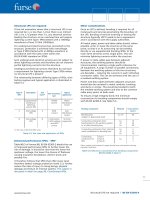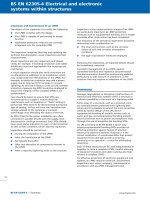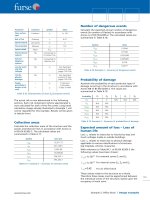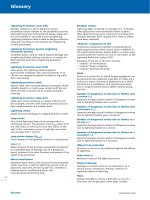Bsi bs en 00847 3 2013
Bạn đang xem bản rút gọn của tài liệu. Xem và tải ngay bản đầy đủ của tài liệu tại đây (903.23 KB, 18 trang )
BS EN 847-3:2013
BSI Standards Publication
Tools for woodworking —
Safety requirements
Part 3: Clamping devices
BS EN 847-3:2013
BRITISH STANDARD
National foreword
This British Standard is the UK implementation of EN 847-3:2013. It
supersedes BS EN 847-3:2004 which is withdrawn.
The UK participation in its preparation was entrusted to Technical
Committee MTE/23, Woodworking machines.
A list of organizations represented on this committee can be
obtained on request to its secretary.
This publication does not purport to include all the necessary
provisions of a contract. Users are responsible for its correct
application.
© The British Standards Institution 2013. Published by BSI Standards
Limited 2013
ISBN 978 0 580 75763 1
ICS 79.120.10
Compliance with a British Standard cannot confer immunity from
legal obligations.
This British Standard was published under the authority of the
Standards Policy and Strategy Committee on 31 October 2013.
Amendments issued since publication
Date
Text affected
BS EN 847-3:2013
EN 847-3
EUROPEAN STANDARD
NORME EUROPÉENNE
EUROPÄISCHE NORM
October 2013
ICS 79.120.10
Supersedes EN 847-3:2004
English Version
Tools for woodworking - Safety requirements - Part 3: Clamping
devices
Outils pour le travail du bois - Prescriptions de sécurité Partie 3: Outils de serrage
Maschinen-Werkzeuge für Holzbearbeitung Sicherheitstechnische Anforderungen - Teil 3: Spannzeuge
This European Standard was approved by CEN on 10 August 2013.
CEN members are bound to comply with the CEN/CENELEC Internal Regulations which stipulate the conditions for giving this European
Standard the status of a national standard without any alteration. Up-to-date lists and bibliographical references concerning such national
standards may be obtained on application to the CEN-CENELEC Management Centre or to any CEN member.
This European Standard exists in three official versions (English, French, German). A version in any other language made by translation
under the responsibility of a CEN member into its own language and notified to the CEN-CENELEC Management Centre has the same
status as the official versions.
CEN members are the national standards bodies of Austria, Belgium, Bulgaria, Croatia, Cyprus, Czech Republic, Denmark, Estonia,
Finland, Former Yugoslav Republic of Macedonia, France, Germany, Greece, Hungary, Iceland, Ireland, Italy, Latvia, Lithuania,
Luxembourg, Malta, Netherlands, Norway, Poland, Portugal, Romania, Slovakia, Slovenia, Spain, Sweden, Switzerland, Turkey and United
Kingdom.
EUROPEAN COMMITTEE FOR STANDARDIZATION
COMITÉ EUROPÉEN DE NORMALISATION
EUROPÄISCHES KOMITEE FÜR NORMUNG
CEN-CENELEC Management Centre: Avenue Marnix 17, B-1000 Brussels
© 2013 CEN
All rights of exploitation in any form and by any means reserved
worldwide for CEN national Members.
Ref. No. EN 847-3:2013: E
BS EN 847-3:2013
EN 847-3:2013 (E)
Contents
Page
Foreword ..............................................................................................................................................................3
Introduction .........................................................................................................................................................4
1
Scope ......................................................................................................................................................5
2
Normative references ............................................................................................................................5
3
Terms and definitions ...........................................................................................................................5
4
List of significant hazards ....................................................................................................................6
5
5.1
5.2
5.3
5.4
5.5
5.5.1
5.5.2
5.5.3
5.6
Design requirements .............................................................................................................................7
General ....................................................................................................................................................7
Hydrostatic clamping devices with open system ...............................................................................7
Shape ......................................................................................................................................................7
Balance ...................................................................................................................................................7
Testing ....................................................................................................................................................8
Test sample and dimensions................................................................................................................8
Formulae and calculation .................................................................................................................. 10
Test procedure .................................................................................................................................... 10
Requirements on tolerances of clamping devices .......................................................................... 11
6
6.1
6.2
6.3
6.4
Marking of clamping devices ............................................................................................................. 11
General ................................................................................................................................................. 11
Marking of clamping devices for bore mounted tools .................................................................... 11
Marking of clamping devices for shank mounted tools ................................................................. 11
Marking of one piece clamping devices for shank mounted tools ................................................ 12
7
7.1
7.2
Information for use ............................................................................................................................. 12
General ................................................................................................................................................. 12
Safe working practice ......................................................................................................................... 12
Bibliography ..................................................................................................................................................... 13
2
BS EN 847-3:2013
EN 847-3:2013 (E)
Foreword
This document (EN 847-3:2013) has been prepared by Technical Committee CEN/TC 142 “Woodworking
machines - Safety”, the secretariat of which is held by UNI.
This European Standard shall be given the status of a national standard, either by publication of an identical
text or by endorsement, at the latest by April 2014, and conflicting national standards shall be withdrawn at the
latest by April 2014.
Attention is drawn to the possibility that some of the elements of this document may be the subject of patent
rights. CEN [and/or CENELEC] shall not be held responsible for identifying any or all such patent rights.
This document supersedes EN 847-3:2004.
The following table contains a list of modifications from the previous edition.
EN 847-3:2004
EN 847-3:2013
Reason
3 Terms
3 Terms and definitions:
new headline
some new definitions
ed/te
5 Safety requirements
5 Design requirements:
new numbering
ed
7 Information for use
7 Information for use; with 7.2 Safe
working practice
ed
Annex A: Safe work practice
No Annex A
ed
New: Bibliography
ed
According to the CEN-CENELEC Internal Regulations, the national standards organisations of the following
countries are bound to implement this European Standard: Austria, Belgium, Bulgaria, Croatia, Cyprus, Czech
Republic, Denmark, Estonia, Finland, Former Yugoslav Republic of Macedonia, France, Germany, Greece,
Hungary, Iceland, Ireland, Italy, Latvia, Lithuania, Luxembourg, Malta, Netherlands, Norway, Poland, Portugal,
Romania, Slovakia, Slovenia, Spain, Sweden, Switzerland, Turkey and the United Kingdom.
3
BS EN 847-3:2013
EN 847-3:2013 (E)
Introduction
This European Standard specifies general requirements for the safety of clamping devices for machine tools for
woodworking.
It is addressed to manufacturers and it is useful for end users.
4
BS EN 847-3:2013
EN 847-3:2013 (E)
1
Scope
This European Standard specifies all hazards arising from the use of clamping devices for the fastening of
milling tools and circular saw blades on woodworking machines and specifies the methods for the elimination
or reduction of these hazards by the design of the clamping device and by the provision of information.
This European Standard does not apply to arbors for spindle moulding machines in accordance with EN 848-1
or to clamping flanges for circular sawing blades to be used on circular sawing machines in accordance with
the standard series EN 1870 and does not cover hazard related to the connection of the clamping device with
the machine.
Bore mounted tools which are mounted on an interchangeable arbor should be considered as a shank
mounted tool.
NOTE
2
For definition of "woodworking machines", see EN 847-1.
Normative references
The following documents, in whole or in part, are normatively referenced in this document and are
indispensable for its application. For dated references, only the edition cited applies. For undated references,
the latest edition of the referenced document (including any amendments) applies.
EN 847-1:2013, Tools for woodworking — Safety requirements — Part 1: Milling tools, circular saw blades
ISO 1940-1, Mechanical vibration — Balance quality requirements for rotors in a constant (rigid) state —
Part 1: Specification and verification of balance tolerances
ISO 10897, Collets for tool holders with taper ratio 1:10 — Collets, holders, nuts
ISO 15488, Collets with 8 degree setting angle for tool shanks — Collets, nuts and fitting dimensions
3
Terms and definitions
For the purposes of this document, the terms and definitions given in EN 847-1:2013 and the following apply.
3.1
shank
part of the tool by which it is held
[SOURCE: ISO 3002-1:1982, 3.2.2]
3.2
shank mounted tool
tool with a shank
3.3
bore mounted tool
tool with a bore for mounting
3.4
tool bore
that bore in a tool by which it can be located and fixed by a spindle, arbour or mandrel
[SOURCE: ISO 3002-1:1982, 3.2.3]
5
BS EN 847-3:2013
EN 847-3:2013 (E)
3.5
clamping device
element for fixing the tool on the driving spindle of the woodworking machine, for transferring the torque of the
driving spindle and for positioning of the tool
3.5.1
friction lock clamping device
clamping device where the connection between tool and clamping device as well as the positioning of the tool
is achieved by friction lock fixing elements (e.g. by spring tensions, gripping elements, hydrostatic clamping
elements)
3.5.1.1
clamping device with mechanical clamping fixture
clamping device where gripping of the tool in the clamping device is performed mechanically, e.g. by spring
tension, gripping elements
3.5.1.2
clamping device with hydrostatic clamping fixture
clamping device where gripping of the tool in the clamping device is performed hydrostatically, e.g. by
hydrostatic clamping elements
3.5.1.2.1
hydrostatic clamping element
element which neutralises tolerances between the woodworking tool and the clamping device by elastic
deformation
Note 1 to entry:
The deformation is generated by hydrostatic pressure.
3.5.1.2.2
open system clamping device
clamping device where the clamping medium (incompressible fluid, e.g. oil, grease) can escape when
released and is supplied from the outside when clamped
3.5.1.2.3
close system clamping device
clamping device where the clamping medium is permanently and pressure-tightly retained in the system
3.5.1.3
one piece clamping device
solid clamping device where the clamping force is generated by the elasticity of its material, e.g. shrink chuck
3.5.2
form lock clamping device
clamping device where the connection between tool and clamping device is achieved by form lock fixing
elements, e.g. bayonet type clamping, flatted cylindrical shanks
3.6
maximum rotational speed
maximum rotational speed for the operation for which the clamping device is designed
4
List of significant hazards
Table 1 shows the list of significant hazards.
6
BS EN 847-3:2013
EN 847-3:2013 (E)
Table 1 — List of significant hazards
Condition or causes of the hazard related
to the clamping device
Hazard
Ejection of parts
Vibrations
5
Corresponding
clause of
EN 847-3
Incorrect assembly of the clamping device
5.6
Modification of tool position relative to the clamping
device
7.2
Dynamic unbalance of the clamping device while rotating
5.4
Loosening of the tool in/on the clamping device during
machining
7.2
Fastening of the clamping device on the driving spindle
7.2
Dynamic unbalance of the clamping device
5.4
Design requirements
5.1
General
Clamping devices shall be designed and made of such materials that they withstand the forces and loads
expected during operation.
Verification: By test procedure described in 5.5.3.
NOTE
For the calculation of the shank strength, see EN 847-2.
In the area of the mounted surface, clamping devices shall be compatible to woodworking tools.
5.2
Hydrostatic clamping devices with open system
Hydrostatic clamping devices with open system shall be designed to retain the tool in the clamping device in
the event of the loss of pressure, e.g. by an additional mechanical locking.
Verification: By checking the relevant drawings and visual inspection of the clamping device.
5.3
Shape
The cross-section of clamping devices shall have a circular form perpendicular to the axis of rotation.
The following exceptions of the circular form are permissible:
thread holes for fixing, balancing screws and balancing holes;
widths across flats;
shape and dimensions according to the sizes of the wrenches;
balancing flats for systems with flatted tool shanks.
Verification: By checking the relevant drawings, measurement and visual inspection of the clamping device.
5.4
Balance
Clamping devices having a mass greater than 0,5 kg shall be balanced.
7
BS EN 847-3:2013
EN 847-3:2013 (E)
Clamping devices with keyways inside the bore shall be balanced without keys and clamping devices with
keyways on the outside diameter shall be balanced with keys.
Maximum rotational speed
–1
in min
nmax
Permissible residual unbalance for clamping devices U T∗ in
g ⋅ mm
kg
The balance quality requirements shown in Table 2 shall be applied.
Table 2 — Minimum balance quality requirements
Number
Type of
clamping devices
1
Clamping devices
in general
2
Clamping devices with
movable parts of at
least 15 % of the total
mass
G-value = eper
according to
ISO 1940-1
6,3
16
Formula
(expands ISO 1940-1)
U T* = 0,6016 ⋅ 10 5 ⋅
U T* = 1,5279 ⋅ 10 5 ⋅
1
nmax
1
nmax
Explanation of the formula
The value of 0,601 6 is the
product of
e per ⋅ ω ⋅ 10 3 ⋅
60
2⋅π
The value of 1,527 9 is the
product of
e per ⋅ ω ⋅ 10 3 ⋅
60
2⋅π
Verification: By measurement of the clamping device.
5.5
Testing
5.5.1
Test sample and dimensions
One-piece sleeves and one-piece arbors shall not be tested. Arbors with form lock elements (e.g. keys) shall
be counted as a single element.
Test rotational speed:
np = 1,5 × nmax.
Test torsional moment: Mp = 1,5 × Mmax.
The values (Mmax, nmax, t) and required dimensions shall be determined.
The test sample for clamping devices for bore mounted tools shall have a cylindrical shape and contain a
required mounting bore (e.g. bore, hollow taper).
The test sample for clamping devices for shank mounted tools consists of a cylindrical part with an appropriate
mounting shank (e.g. cylindrical shank, hollow taper shank).
The tolerances of the test sample shall be in accordance with the tolerances of the clamping device.
The balance quality of the test sample shall be G40 for complex tools (see EN 847-1).
The specific density ρ of the test sample shall be 7,85 kg/dm .
3
Test sample dimensions are given in Figure 1.
8
BS EN 847-3:2013
EN 847-3:2013 (E)
a) Clamping device with a test sample with shank
b) Clamping device with a test sample with bore
Key
1
clamping device
2
test piece
nmax
maximum rotational speed in min−
l1
body width of the test piece in mm
v
peripheral speed in m/s
angular acceleration in s−
1
Fp
test force in N
α
ω
rp
Mp
test radius in mm
test torsional moment in Nm
JB
JC
angular velocity in s
2
mass inertia moment (share of the bore) in kgm
2
mass inertia moment (share of the test piece without shank) in kgm
JS
mass inertia moment (share of the shank) in kgm
Mp = Fp × rp × 10
np
2
−1
3
test rotational speed in min−
1
t
r2
deceleration time in s
shank radius in mm
r1
Mmax
outside radius in mm
maximum torsional moment in Nm
lg
shank length in mm
2
2
JT
mass inertia moment kgm
ρ
specific density in kg/dm
3
Figure 1 — Test sample dimensions
9
BS EN 847-3:2013
EN 847-3:2013 (E)
5.5.2
Formulae and calculation
For the calculation of the body width of the test piece the following formulae apply:
30 ⋅ t
J T = M p ⋅
π ⋅ nmax
(1)
where
JT is:
with shank J T = J C + J S
(2)
with bore J T = J C − J B
(3)
For test bodies with cylindrical shank:
4
M p ⋅ 60
r
t
⋅ 4 ⋅ 10 12 − 2 ⋅ l g
l1 = 2
π ⋅ ρ ⋅ n
r1
r1
p
(4)
If the processes of acceleration or deceleration are not constant, the maximum partial acceleration
(∆α = ∆v/∆t) shall be considered.
EXAMPLE
5.5.3
Example of calculation:
Test torsional moment
Mp
=
40,0 Nm
Test rotational speed
np
=
27 000 min−
Deceleration time
t
=
0,5 s
Shank radius
r2
=
12,5 mm
Shank length
lg
=
50,0 mm
Outside radius
r1
=
53,0 mm
Body width of the test piece
l1
=
72,2 mm
Specific density
ρ
=
7,85 kg/dm3
1
Test procedure
The test procedure is the following:
a)
The test sample shall be mounted in or on the clamping device.
b)
The maximum torsional moment Mmax and the maximum rotational speed nmax shall be determined. The
minimum clamping length must be specified by the manufacturer of the clamping device.
c)
The mounted test sample shall be constantly accelerated to the maximum rotational speed within 10 s
and shall operate for the duration of one minute at the maximum rotational speed. After that the test piece
shall be constantly decelerated within 10 s.
d)
Check whether Mmax can be transmitted.
10
BS EN 847-3:2013
EN 847-3:2013 (E)
e)
The mounted test sample shall be accelerated within 8 s to 10 s to the test rotational speed according to
5.3.2 and shall operate for the duration of 10 min at the test rotational speed.
f)
The test sample shall be decelerated within 8 s to 10 s from the test rotational speed to standstill.
g)
Check whether 0,9 × Mp can be transmitted.
The test is fulfilled if both d) and g) are satisfied.
Verification: Measurement of the torsional moment which shall be in accordance with f).
NOTE
The transmittable rotational moment is determined by this test c) and e), taking only into account alterations
depending on the system (e.g. seating of elements of the test piece after acceleration and deceleration, changes of the
position of system elements).
5.6
Requirements on tolerances of clamping devices
The requirements on tolerances of clamping devices shall be determined.
Verification: By the test described in 5.5.3 for the most unfavourable combination of tolerances.
6
6.1
Marking of clamping devices
General
Clamping devices shall be clearly and permanently marked.
Permanently marked means, e.g. engraving, etching or embossing stamping. A character height of 3 mm,
where possible, is considered acceptable for clear marking.
Verification: By checking the relevant drawing and visual inspection.
6.2
Marking of clamping devices for bore mounted tools
Clamping devices for bore mounted tools shall be clearly and permanently marked at least with the
name or trademark of the manufacturer or supplier;
maximum rotational speed, e.g. n max. 6 000.
6.3
Marking of clamping devices for shank mounted tools
Bodies for clamping devices for shank mounted tools shall be clearly and permanently marked at least with
the
name or trademark of the manufacturer or supplier;
maximum rotational speed, e.g. n max. 18 000.
Collet chuck holder shall be clearly and permanently additionally marked with the type of collet in accordance
with ISO 10897 and ISO 15488 (e.g. 472 E).
The part of the clamping devices which fixes the tool shall be clearly and permanently marked with the
nominal diameter of the tool shank or, if applicable, the clamping range.
11
BS EN 847-3:2013
EN 847-3:2013 (E)
6.4
Marking of one piece clamping devices for shank mounted tools
One piece clamping devices for shank mounted tools shall be clearly and permanently marked at least with
the
name or trademark of the manufacturer or supplier;
the required diameter and tolerances of the tool shank.
7
Information for use
7.1
General
The information for use shall contain all information marked on the clamping devices and, in addition, name and
address of the manufacturer or supplier.
7.2
Safe working practice
The following information of the safe working practice shall be given, if applicable.
a)
Maximum rotational speed.
b)
Compare the speeds indicated on the clamping device and on the tool to be clamped. For adjusting the
speed on the machine the lower speed shall be applied.
c)
Fastening of clamping devices and tools:
1)
Screws and nuts shall be tightened using the appropriate spanners.
2)
Clamping surfaces shall be cleaned to remove dirt, grease, oil and water.
3)
Clamping devices and tools shall be mounted or clamped according to given torques, pressures and
wrenches to be used.
4)
Extension of spanners or tightening or loosening by means of hammer blows shall not be permitted.
5)
Maximum tool diameters and tool lengths shall not be exceeded.
6)
Shank diameters shall be in accordance with the clamping range of the clamping devices.
7)
The minimum required clamping length shall be kept.
d)
Use of clamping devices with integrated data medium. Care shall be taken that the data relevant to the
safety of the clamped tool are always stored in the data medium.
e)
For repair of clamping devices particular attention shall be given to the following:
1)
Repairs shall only be carried out by a competent person, i.e. a person with professional training and
experience, who has knowledge of the design, construction and safety requirements.
2)
Repair shall therefore include, e.g. the use of spare parts which are in compliance with the
specifications of the original parts.
Verification: By checking the information for use.
12
BS EN 847-3:2013
EN 847-3:2013 (E)
Bibliography
[1] EN 847-2, Tools for woodworking — Safety requirements — Part 2: Requirements for the shank of shank
mounted milling tools
[2] EN 848-1, Safety of woodworking machines — One side moulding machines with rotating tool — Part 1:
Single spindle vertical moulding machines
[3] EN 1870-3, Safety of woodworking machines — Circular sawing machines — Part 3: Down cutting
cross-cut saws and dual purpose down cutting cross-cut saws/circular saw benches
[4] EN 1870-4, Safety of woodworking machines — Circular sawing machines — Part 4: Multiblade rip
sawing machines with manual loading and/or unloading
[5] EN 1870-5, Safety of woodworking machines — Circular sawing machines — Part 5: Circular sawbenches/up-cutting cross-cut sawing machines
[6] EN 1870-6, Safety of woodworking machines — Circular sawing machines — Part 6: Circular sawing
machines for firewood and dual purpose circular sawing machines for firewood/circular saw benches, with
manual loading and/or unloading
[7] EN 1870-7, Safety of woodworking machines — Circular sawing machines — Part 7: Single blade log
sawing machines with integrated feed table and manual loading and/or unloading
[8] EN 1870-8, Safety of woodworking machines — Circular sawing machines — Part 8: Single blade edging
circular rip sawing machines with power driven saw unit and manual loading and/or unloading
[9] EN 1870-9, Safety of woodworking machines — Circular sawing machines — Part 9: Double blade
circular sawing machines for cross-cutting with integrated feed and with manual loading and/or unloading
[10] EN 1870-10, Safety of woodworking machines — Circular sawing machines — Part 10: Single blade
automatic and semi-automatic up-cutting cross-cut sawing machines
[11] EN 1870-11, Safety of woodworking machines — Circular sawing machines — Part 11: Semi-automatic
and automatic horizontal cross-cut sawing machines with one saw unit (radial arm saws)
[12] EN 1870-13, Safety of woodworking machines — Circular sawing machines — Part 13: Horizontal beam
panel sawing machines
[13] EN 1870-14, Safety of woodworking machines — Circular sawing machines — Part 14: Vertical panel
sawing machines
[14] EN 1870-15, Safety of woodworking machines — Circular sawing machines — Part 15: Multi-blade crosscut sawing machines with integrated feed of the workpiece and manual loading and/or unloading
[15] EN 1870-16, Safety of woodworking machines — Circular sawing machines — Part 16: Double mitre
sawing machines for V cutting
[16] EN 1870-17, Safety of woodworking machines — Circular sawing machines — Part 17: Manual horizontal
cutting cross-cut sawing machines with one saw unit (radial arm saws)
[17] EN 1870-18, Safety of woodworking machines — Circular sawing machines — Part 18: Dimension saws
[18] ISO 3002-1:1982, Basic quantities in cutting and grinding — Part 1: Geometry of the active part of cutting
tools — General terms, reference systems, tool and working angles, chip breakers
13
This page deliberately left blank
This page deliberately left blank
NO COPYING WITHOUT BSI PERMISSION EXCEPT AS PERMITTED BY COPYRIGHT LAW
British Standards Institution (BSI)
BSI is the national body responsible for preparing British Standards and other
standards-related publications, information and services.
BSI is incorporated by Royal Charter. British Standards and other standardization
products are published by BSI Standards Limited.
About us
Revisions
We bring together business, industry, government, consumers, innovators
and others to shape their combined experience and expertise into standards
-based solutions.
Our British Standards and other publications are updated by amendment or revision.
The knowledge embodied in our standards has been carefully assembled in
a dependable format and refined through our open consultation process.
Organizations of all sizes and across all sectors choose standards to help
them achieve their goals.
Information on standards
We can provide you with the knowledge that your organization needs
to succeed. Find out more about British Standards by visiting our website at
bsigroup.com/standards or contacting our Customer Services team or
Knowledge Centre.
Buying standards
You can buy and download PDF versions of BSI publications, including British
and adopted European and international standards, through our website at
bsigroup.com/shop, where hard copies can also be purchased.
If you need international and foreign standards from other Standards Development
Organizations, hard copies can be ordered from our Customer Services team.
Subscriptions
Our range of subscription services are designed to make using standards
easier for you. For further information on our subscription products go to
bsigroup.com/subscriptions.
With British Standards Online (BSOL) you’ll have instant access to over 55,000
British and adopted European and international standards from your desktop.
It’s available 24/7 and is refreshed daily so you’ll always be up to date.
You can keep in touch with standards developments and receive substantial
discounts on the purchase price of standards, both in single copy and subscription
format, by becoming a BSI Subscribing Member.
PLUS is an updating service exclusive to BSI Subscribing Members. You will
automatically receive the latest hard copy of your standards when they’re
revised or replaced.
To find out more about becoming a BSI Subscribing Member and the benefits
of membership, please visit bsigroup.com/shop.
With a Multi-User Network Licence (MUNL) you are able to host standards
publications on your intranet. Licences can cover as few or as many users as you
wish. With updates supplied as soon as they’re available, you can be sure your
documentation is current. For further information, email
BSI Group Headquarters
389 Chiswick High Road London W4 4AL UK
We continually improve the quality of our products and services to benefit your
business. If you find an inaccuracy or ambiguity within a British Standard or other
BSI publication please inform the Knowledge Centre.
Copyright
All the data, software and documentation set out in all British Standards and
other BSI publications are the property of and copyrighted by BSI, or some person
or entity that owns copyright in the information used (such as the international
standardization bodies) and has formally licensed such information to BSI for
commercial publication and use. Except as permitted under the Copyright, Designs
and Patents Act 1988 no extract may be reproduced, stored in a retrieval system
or transmitted in any form or by any means – electronic, photocopying, recording
or otherwise – without prior written permission from BSI. Details and advice can
be obtained from the Copyright & Licensing Department.
Useful Contacts:
Customer Services
Tel: +44 845 086 9001
Email (orders):
Email (enquiries):
Subscriptions
Tel: +44 845 086 9001
Email:
Knowledge Centre
Tel: +44 20 8996 7004
Email:
Copyright & Licensing
Tel: +44 20 8996 7070
Email:
